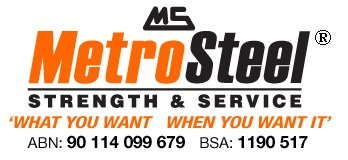Have you ever wondered just how steel goes from the initial raw product to the variety of items used in the building and construction industry? While it can be a relatively lengthy process, it can be broken down into 6 steps. With this in mind, let’s take a closer look.
Step 1 – Iron-Making
In order to make pure steel the raw products of iron ore, lime, and coke need to be first turned into iron. The products are placed in the blast furnace and melted to form what’s known as “hot metal’ or ‘molten iron’. At this stage the iron still contains a lot of impurities which will make the metal brittle, so much of it then needs to be removed.
Step 2 – Primary Steel-Making
In order to remove many of the impurities, scrap steel is then added to the molten metal and if the Basic Oxygen Steel Making (BOS) process is used then oxygen is forcibly blown through the furnace. This in turn reduces the carbon content and other impurities. Alternatively if Electric Arc Furnaces (EAF’s) are used, then electricity is blasted through the molten metal achieving the same results. Once completed then we’re left with steel in its rawest form.
Step 3 – Secondary Steel Making
Certain grades of steel vary depending upon their use. Grading is usually signified by which elements are left (primarily carbon) or which extra elements are added. For example, for Drawing Quality or (DQ) steel, most of the carbon content is removed but aluminium is added. This makes for a greater degree of ductility. Alternatively, for structural steel the carbon levels need to be higher giving the steel a higher tensile strength. There are certain techniques or processes that can be used to tweak the levels of impurities and these include:
-
Temperature increase or decrease
-
Degassing
-
Stirring
-
Ladle injection
Once the right processes have been carried out and the metal has reached the right grade, the next step can take place.
Step 4 – Continual Casting
The molten steel is directly cast into cooling moulds which causes solidifying of the the thin steel shell. This is withdrawn while still warm using guided rollers and is then cut into desired lengths and parts for further production eg, steel slabs for plates, strips for sections such as beams, and billets for longer products such as wiring. Once completely cooled, the parts are then sent off to the various departments for primary forging.
Step 5 – Primary Forging
Primary forging is the process of turning the rough cast items into recognisable shapes by a process known as hot rolling. Hot rolling eliminates any casting defects while turning the products into the desired shape and quality. The process itself can produce long products, seamless tubing, flat products, and even speciality products.
Step 6 – Secondary Forming Techniques
A variety of secondary forming techniques gives the steel its final shape and properties. These can include:
-
Joining
-
Heat treatment
-
Coating
-
Machining
-
Drilling
-
Pressing and
-
Riveting
So there you have it! If you have a particular project in mind and need a trustworthy and reliable steel fabrication service, then come and talk to Metro Steel. We’ve been in the fabrication business for many years and have the experience and the skills to turn your bespoke plans or drawings into workable fully functioning objects. For a free no-obligation quote, contact us today on 07 3204 1000.
 Talk to an Expert (07) 3204 1000
Talk to an Expert (07) 3204 1000 Working Hours - Mon – Fri 7:00 AM – 4:00 PM
Working Hours - Mon – Fri 7:00 AM – 4:00 PM